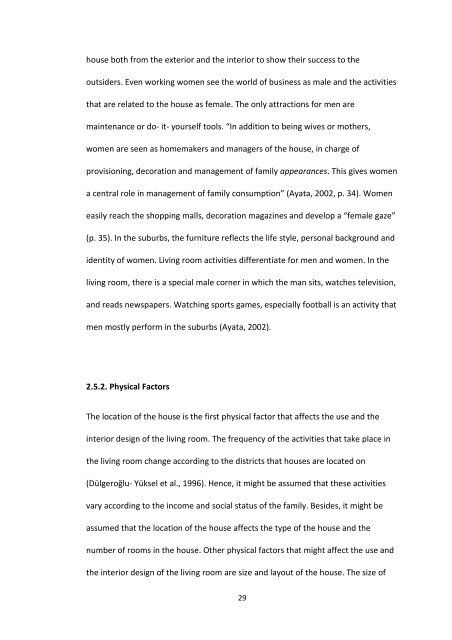private and public use of the living room - Bilkent University
private and public use of the living room - Bilkent University
private and public use of the living room - Bilkent University
You also want an ePaper? Increase the reach of your titles
YUMPU automatically turns print PDFs into web optimized ePapers that Google loves.
ho<strong>use</strong> both from <strong>the</strong> exterior <strong>and</strong> <strong>the</strong> interior to show <strong>the</strong>ir success to <strong>the</strong><br />
outsiders. Even working women see <strong>the</strong> world <strong>of</strong> business as male <strong>and</strong> <strong>the</strong> activities<br />
that are related to <strong>the</strong> ho<strong>use</strong> as female. The only attractions for men are<br />
maintenance or do- it- yourself tools. “In addition to being wives or mo<strong>the</strong>rs,<br />
women are seen as homemakers <strong>and</strong> managers <strong>of</strong> <strong>the</strong> ho<strong>use</strong>, in charge <strong>of</strong><br />
provisioning, decoration <strong>and</strong> management <strong>of</strong> family appearances. This gives women<br />
a central role in management <strong>of</strong> family consumption” (Ayata, 2002, p. 34). Women<br />
easily reach <strong>the</strong> shopping malls, decoration magazines <strong>and</strong> develop a “female gaze”<br />
(p. 35). In <strong>the</strong> suburbs, <strong>the</strong> furniture reflects <strong>the</strong> life style, personal background <strong>and</strong><br />
identity <strong>of</strong> women. Living <strong>room</strong> activities differentiate for men <strong>and</strong> women. In <strong>the</strong><br />
<strong>living</strong> <strong>room</strong>, <strong>the</strong>re is a special male corner in which <strong>the</strong> man sits, watches television,<br />
<strong>and</strong> reads newspapers. Watching sports games, especially football is an activity that<br />
men mostly perform in <strong>the</strong> suburbs (Ayata, 2002).<br />
2.5.2. Physical Factors<br />
The location <strong>of</strong> <strong>the</strong> ho<strong>use</strong> is <strong>the</strong> first physical factor that affects <strong>the</strong> <strong>use</strong> <strong>and</strong> <strong>the</strong><br />
interior design <strong>of</strong> <strong>the</strong> <strong>living</strong> <strong>room</strong>. The frequency <strong>of</strong> <strong>the</strong> activities that take place in<br />
<strong>the</strong> <strong>living</strong> <strong>room</strong> change according to <strong>the</strong> districts that ho<strong>use</strong>s are located on<br />
(Dülgeroğlu- Yüksel et al., 1996). Hence, it might be assumed that <strong>the</strong>se activities<br />
vary according to <strong>the</strong> income <strong>and</strong> social status <strong>of</strong> <strong>the</strong> family. Besides, it might be<br />
assumed that <strong>the</strong> location <strong>of</strong> <strong>the</strong> ho<strong>use</strong> affects <strong>the</strong> type <strong>of</strong> <strong>the</strong> ho<strong>use</strong> <strong>and</strong> <strong>the</strong><br />
number <strong>of</strong> <strong>room</strong>s in <strong>the</strong> ho<strong>use</strong>. O<strong>the</strong>r physical factors that might affect <strong>the</strong> <strong>use</strong> <strong>and</strong><br />
<strong>the</strong> interior design <strong>of</strong> <strong>the</strong> <strong>living</strong> <strong>room</strong> are size <strong>and</strong> layout <strong>of</strong> <strong>the</strong> ho<strong>use</strong>. The size <strong>of</strong><br />
29
















